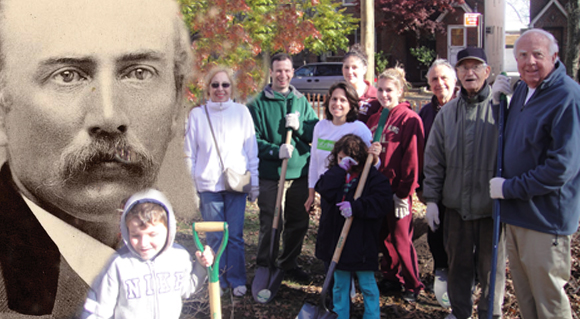If you visit Nebraska today you wouldn’t know that it was once a treeless plain. It was the lack of trees that led to the founding of Arbor Day in the 1800s.
Among the pioneers moving into the Nebraska territory in 1854 was J.Sterling Morton from Detroit, Michigan. He and his wife were lovers of nature and the home they established was soon planted with trees, shrubs and flowers.
Morton was a journalist and soon became the editor of Nebraska’s first newspaper. Given that forum he spread agricultural information and his enthusiasm to an equally enthusiastic readership. His fellow pioneers missed their trees but more importantly trees were needed as windbreaks to keep soil from blowing away as well as for fuel, building materials and shade from the hot sun.
In 1872, Morton first proposed a tree planting holiday to be called “Arbor Day” at a meeting of the State Board of Agriculture. Prizes were offered to counties and individuals for planting the most trees. It was established that more than 1 million trees were planted that day.
In 1883, Arbor Day was named a legal holiday in Nebraska, and April 22nd, Morton’s birthday, was selected as the day for observance. The idea spread to other states over the years, and it is observed on different dates according to the best time to plant trees.
J. Sterling Morton died in 1902, and President Grover Cleveland dedicated a memorial to him at Arbor Lodge in 1905. One of Morton’s own phrases adorns the marker, “Other holidays repose upon the past, Arbor Day proposes the future.”
The Arbor Farm
Morton’s home and farm in Nebraska City became Arbor Lodge and it now contains extensive plantings of more than 160 species of trees and shrubs. In 1972 one hundred years from the date of the first Arbor Day, the Arbor Day Foundation was created to encourage the planting of trees in the city and country. They provide many educational programs to schools and they make available to non-profit organizations tree and shrubs for sale as fundraisers and members receive free trees each year.
Visitors can go to the Arbor Farm and stay at a beautiful Adirondack style lodge and enjoy fine dining and go on nature walks in the woods and orchards. There are many exhibits and classes to educate young and old on the importance of trees. There is also a conference center and an environmentally friendly golf course that was designed by Jack Nicklaus. For those who really want to unwind in this beautiful surrounding they can go to the spa. There is something here for the whole family to have a wonderful vacation.
The Measurable Threat to Environment
Just in the last few years millions of acres of trees have burned in National Parks from forest fires and many trees have died from diseases and from pests like the Asian Long Horned Beetle. In the rain forests of Central and South America millions of acres of trees have been clear-cut for logs and for creating farmland and areas for cattle grazing. The Arbor Day Foundation has been responsible for the planting of 25 million trees in the National Forests and is educating people who live in the rain forests to manage the trees and sustain the ecology. Much of the earth’s oxygen and many medicines have come from this important area.
NYC’s Million Tree Program
New York City has a program to plant 1 million trees in 10 years and now has 5.2 million trees, 592,130 of them are street trees. With the population expected to rise by 1 million people in the next 10 years this will mean a rise in emissions from power plants and vehicles and the loss of green spaces to construction, we will need more trees to compensate for the loss. The average life expectancy of a street tree is about 7 years because of pollution, vandalism and neglect. The city encourages people to adopt neighborhood trees and learn how to maintain them. The city estimates that for every dollar that is spent on trees the city gets back $5.60 in benefits in removing polluted air and preventing storm water runoff that overwhelms the sewer system.
Yes, there was much destruction from the recent windstorms and many trees that had lived for many years were uprooted, crushed cars and destroyed homes. Thankfully storms like that do not happen very often. Trees give us so much beauty, remove pollution from the air, give us oxygen, provide homes for wildlife, help save energy with shade, block winter winds, prevent soil erosion, absorb storm water runoff to prevent flooding and they increase property values. One has to take a drive to the affluent areas and notice the large stately trees and shrubs that surround the big homes and line the streets.
Let’s invest in the future and plant a tree. Most likely the tree will be around a lot longer than us. Arbor Day in New York is April 29.
For more info on the Arbor Day Foundation write to Arbor Lodge 100 Nebraska City N.E.68410. For information on the Million Tree project and to find out how to get involved with caring for the trees in your neighborhood call 311.




